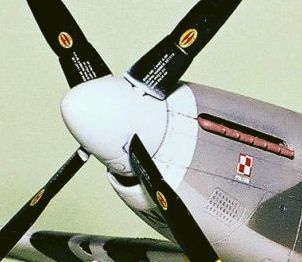ICM 1/48 P-51B in RAF colours
by Wojtek Perkowski
The North American’s legendary P-51 fighter is widely recognized for being a result of a RAF order in the first place and the British initiative to adapt the design to take a Rolls-Royce Merlin engine. The latter moved the aircraft from the position of an low-level tactical fighter of limited use to become the best strategic fighter of the era.
In light of this it may appear ironic that the RAF never received many Merlin-powered Mustangs. Known in the RAF as the Mustang Mk. III, it was agreed that the priority in the delivery of the new fighters would be given unreservedly to the US 8th Air Force. As it turned out, the RAF was only ever able to equip two of its fighter wings with Mustang Mk. IIIs. The first wing became operational in February, 1944, and comprised of no. 19, 65 and 122 Squadrons. The second Mustang wing was the no. 133 Polish Air Force wing. Re-equipped in April 1944, the wing, commanded by the Polish ace Wing Commander Stanislaw Skalski, consisted of no. 306 Torunski , no. 315 Deblinski and no. 316 Warszawski Squadrons. The wing was also joined by no. 129 Sqn RAF, the last of the seven squadrons flying the new Mustangs.
Being a scarce resource, Merlin Mustangs were used by the RAF for specialized operations in which the fighter’s long range and high speed and provided the edge over other available aircraft. Pre-D-day operations included mostly fighter escorts for the Beaufighter and Mosquito strikes against Norway. After the invasion of France, some Mustang units were transferred to Air Defence of Great Britain to fight V-1 flying bombs.
The machine depicted by my model, belonged to 315 Deblinski (Polish) Squadron RAF stationed in Coolham, June 1944. To my knowledge it is the only documented Polish Merlin powered Mustang without the Malcolm Hood canopy usually associated with RAF Mustangs. There were few more probably, but no photos are known till now.
Construction
This quarter-scale kit has been produced by ICM of Ukraine. ICM’s kit has been heavily based on the Tamiya kit of the P-51B, but having the benefit of being less expensive. The Tamiya 1/48 Mustangs are widely acclaimed as the best in this scale and the ICM kit is a virtual duplicate, with minor modifications. The major differences are that there are no alignment pins, and a few parts are slightly different from the Tamiya version. Fore example, there is a clear instrument panel and optional propellers, but no opened canopy. Parts fit and detail definition is also slightly worse than the Tamiya kit. Especially left upper wing part on my model didn’t fit well – ribs inside wheel well interfered with back wall, and it took some work to achieve good fit with fuselage and proper dihedral. The upper engine cover also required some care to fit well.
The rest of construction went rather easy. I utilised Hi Tech resin interior set, and added flat floor according to photos from In Detail book and Verlinden set for P-51D. Some details were scratchbuilt here, proper reflection sight comes from Tamiya Spitfire V with additional photoetched details from Part.
Central right side canopy with open top is Tamiya part, left open window was built with Part photoetch. This example wasn’t fitted with teardrop light behind antenna mast. The mast itself was made of partially flattened 0,5 mm thick hypodermic needle, as kit’s antenna mast didn’t look to well.
Camouflage & markings
The model was first pre-shaded with black Humbrol enamel. Then I applied the camouflage pattern using Humbrol enamels – Humbrol 64 for Medium Sea Grey , no. 106 for Ocean Grey, and Pactra acrylic A16 for RAF Dark Green. All shades were slightly lightened by adding some white.
Prior to painting the Invasion stripes masks made of Tamiya tape for future code letters and fuselage roundels outlines were applied. After painting the ”perfect” invasion stripes, their rough look was replicated by touching up the paint here and there following the available photos of the real PK*N. The tool used was a thin pointed brush.
When you look closely at the reference photos appropriate for your
area of  modelling, you will notice not only D-Day stripes but many other aircraft markings were applied in a rather sloppy way. Fore example, the white overspray on the propeller blades of my model is intentional – it was there on the real aircraft.
modelling, you will notice not only D-Day stripes but many other aircraft markings were applied in a rather sloppy way. Fore example, the white overspray on the propeller blades of my model is intentional – it was there on the real aircraft.
After glossy layer of Sidolux (equivalent for Future Floor Wax here in Poland) Techmod decals were applied and they went very well with Micro Set. Code letters and fuselage roundels outlines were spoiled with thin brush again. PK N sported long yellow wing leading edge from wingtip to fuselage (obviously covered with D-Day Strips), and D-Day Strips weren’t applied on undercarriage covers. 315 Squadron Mustang’s propeller blades roots were often oversprayed with white while nose and spinner were painted. The final satin layer was Sidolux and acrylic Pactra Clear Matt blend.
Model was subject of article in Polish modelling magazine Mini Replika No 27.
This article was originally published in IPMS Stockholm Magazine in October 2003.





